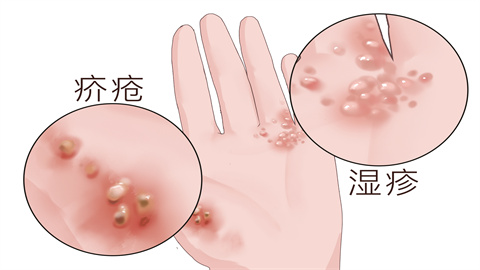What are the differences between scabies and eczema?
Generally, both scabies and eczema can cause skin itching and rashes, but the main differences lie in their causes, commonly affected areas, rash characteristics, itching patterns, and transmissibility. Detailed distinctions are as follows:

1. Different causes: Scabies is caused by Sarcoptes scabiei mites parasitizing the epidermis and is a clear parasitic infectious disease. Its onset is closely related to direct contact with infected individuals or indirect contact via clothing or bedding contaminated by the mites. Eczema is an inflammatory skin disease resulting from both internal and external factors. External factors include contact with pollen, synthetic fabrics, or irritating detergents, while internal factors include a weakened skin barrier, mental stress, and allergic constitution. Eczema has no specific pathogen and is considered a self-induced inflammatory reaction of the skin.
2. Different predilection sites: Scabies tends to affect thin and tender skin areas, commonly occurring between the fingers, on the inner wrists, armpits, and groin. The face and scalp are rarely affected in adults, although infants may develop lesions on the forehead and cheeks due to delicate skin. Eczema can occur all over the body with symmetrical distribution, commonly affecting the cheeks, flexural surfaces of the limbs, and the dorsum of hands and feet, with slightly varying manifestations in different areas.
3. Different rash characteristics: Scabies rashes are uniform in appearance, mainly presenting as small, pale red papules or vesicles the size of a pinhead. Grayish-white, winding burrows created by the mites are often visible between the fingers. The rashes are scattered and do not coalesce. In contrast, eczema rashes are polymorphic, with erythematous patches, vesicles, exudation, and crusts possibly appearing in the same area. The borders are indistinct and lesions tend to merge easily. In chronic stages, thickened, rough skin may develop.
4. Different itching patterns: Scabies itching intensifies significantly at night due to increased mite activity, as their metabolic products and movement stimulate nerve endings. Eczema itching is mostly continuous, slightly worse at night, but without a clear day-night variation. The severity of itching correlates with the degree of inflammation and can be exacerbated by contact with irritants or emotional fluctuations.
5. Different transmissibility: Scabies is highly contagious and classified as a Category C infectious disease, capable of spreading within families or communal living environments through close contact or shared items. Eczema is non-contagious; it cannot be transmitted through contact with patients or shared items and is solely an individual skin condition.
It is recommended that when experiencing skin discomfort, scratching should be avoided to prevent skin damage and secondary infection. Patients with scabies should disinfect clothing and bedding by boiling them in hot water to prevent transmission. Patients with eczema should avoid allergens. Both conditions require treatment under medical guidance to better promote skin recovery.




